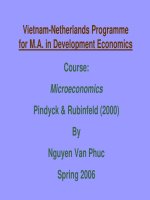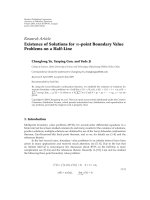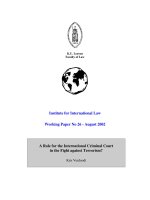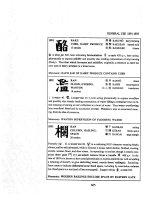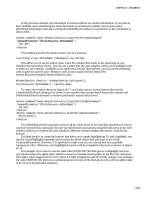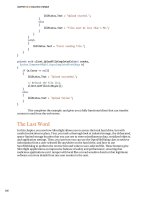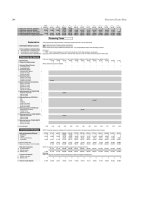valuation for m a Building Value in private companies phần 10 potx
Bạn đang xem bản rút gọn của tài liệu. Xem và tải ngay bản đầy đủ của tài liệu tại đây (110.52 KB, 33 trang )
266
Exhibit 16-6
Cardinal Publishing
: Financial Ratio Summary of Historical Financial Statements
Industry Norm
a
Year 1 Year 2 Year 3 Year 4 Year 5
Current Assets/Current Liabilities
1.3
1.1 1.2 1.3 1.4 1.4
Current Assets Less Inventory/
Current Liabilities
0.9
0.9 1.0 1.0 1.0 1.0
Sales/Receivables
6.4
3.5 3.8 4.1 4.4 4.6
Cost of Sales/Inventory
10.9
7.6 8.2 6.8 6.3 5.8
Cost of Sales/Accounts Payable
8.0
3.1 3.7 3.9 4.4 4.9
Total Debt/Total Debt and Equity
0.42
0.81 0.76 0.72 0.67 0.66
EBIT/Interest Expense
3.9
3.1 3.1 3.4 3.7 3.0
Profit Before Taxes/Total Assets
0.12
0.14 0.13 0.14 0.16 0.11
Profit Before Taxes/Total Equity
0.64
0.76 0.57 0.50 0.50 0.31
Sales/Net Fixed Assets
11.2
4.5 4.9 5.3 5.6 6.0
Sales/Total Assets
2.1
1.4 1.5 1.5 1.7 1.7
Sales to Working Capital
17.5
22.0 13.9 11.1 10.6 9.8
a
The industry norm is averages based on a performance of the five guideline public companies presented in this case for the lat-
est fiscal year.
Exhibit 16-7 Normalized Net Income Years 1 through 5:
Invested Capital Basis (in thousands)
Year 1 Year 2 Year 3 Year 4 Year 5
Pretax Income to Invested
Capital (aka EBIT)
a
6,250 6,600 7,200 8,800 6,900
Adjustments
b
Excess Officer’s Compensation 600 750 800 750 750
Gain on Sale of Land 0 0 0 Ϫ1,500 0
Total Adjustments 600 750 800 Ϫ750 750
Adjusted Pretax Income to
Invested Capital
a
(aka adjusted
EBIT) 6,850 7,350 8,000 8,050 7,650
Normalized Pretax Income to Invested Capital
c
8,000
Income Taxes: Federal and State, estimated at 40%
d
3,200
Normalized Net Income Applicable to Invested Capital 4,800
a
Invested capital is income before the subtraction of interest expense, so it is the return to
debt and equity capital providers.
b
Adjustments: The support and research related to the normalization adjustments are de-
scribed in the narrative portion of the case.
c
This amount was judgmentally selected as representative of Cardinal’s long-term
operating performance as of the end of Year 5. Alternatively, the adjusted pretax in-
come to invested capital of $7,650,000 in Year 5 could be increased by the anticipated
long-term growth rate of 4%, which would have generated approximately the same
amount.
d
This tax rate was supplied by Cardinal’s accounting firm. Because this computation em-
ploys the invested capital model, which is predebt, it does not consider the tax deductibility
of interest expense. An alternative is to reduce the income tax by 40% of interest expense.
Source: Cardinal’s Income Statements for Year 1 through 5.
b
Computation of the Stand-Alone Fair Market Value 267
268 Merger and Acquisition Valuation Case Study
Lou Bertin’s Compensation
Lou Bertin’s compensation package exceeds the market rate. Car-
dinal’s human resources expert’s research indicated that the total
cost of market-rate compensation paid to an arm’s-length CEO of a
publisher the size of Cardinal over the past five years would have
provided the following savings, inclusive of payroll-related burdens:
Year Savings
1 $600,000
2 $750,000
3 $800,000
4 $750,000
5 $750,000
Jeffrey Meier’s Compensation
This position is required for the company’s success, and the salary
is appropriate for a properly qualified VP of Marketing. Thus, no
adjustment is required.
Market Research
In three of the past five years, Cardinal has spent between
$200,000 and $300,000 for market research to allow the company
to better understand its customer base. While some would argue
that this is a nonrecurring expense that should be added back to
determine normalized income, it was concluded that these costs
enable the company to offer the attractive products that make it
uniquely appealing to its customers. This adjustment is a judg-
ment call and is considered to be a recurring cost because it is
necessary for the company to remain competitive in the long
term.
Gain on Sale of Land
The company sold land in Year 4 for $1.8 million that generated a
gain of $1.5 million. Since this is not part of the company’s ongo-
ing income, it is subtracted as a normalization adjustment.
Computation of the Stand-Alone Fair Market Value 269
Other Assets
These assets include vacant land adjacent to the company and a va-
cation home in St. Maarten used by Bertin exclusively for personal
purposes. These assets do not generate income or expenses, so no
adjustment to the income statement is required. Their market
value can be added to the operating value to yield Cardinal’s total
equity value.
Risk and Value Drivers
The factors that should influence the development of the discount
and capitalization rates appropriate to Cardinal’s stand-alone fair
market value are described in the following sections. Exhibits 16-8
and 16-9 are used to develop the rates.
Economic Conditions
Lower forecasted advertising expenditures are expected to hurt all
magazine companies in the next 12 months as economic condi-
tions generally decline.
Industry and Competitive Considerations
Industry sales are dominated by conglomerates, which possess
stronger ties to advertisers and much stronger distribution systems.
Independents face higher operating costs, such as paper costs and
postage rates, and are weaker technologically. Numerous magazines
are launched yearly, with more than half failing within 12 months,
and of the remaining, 95% will fail within five years of introduction.
Financial Condition and Access to Capital
The company carries substantial debt and lacks capital for tech-
nology upgrades.
Management
Lou Bertin, who is approaching the typical retirement age, is
the only Cardinal employee capable of providing executive
270 Merger and Acquisition Valuation Case Study
Exhibit 16-8 Rates Applicable to Net Income to Equity (As of the
Appraisal Date)
Symbol Component Increment Rate
Long-Term Treasury Bond Yield
a
6.00%
ϩ Equity Risk Premium (R
m
Ϫ R
f
)
b
7.50%
ϭ Average Market Return for Large-Cap Stock 13.50%
ϩ Risk Premium for Size
c
5.50%
ϭ Average Market Return Adjusted to
Tenth-Decile-Size Firm 19.00%
Specific Company Risk Premium:
ϩ Industry Risk (larger, stronger competitors) 3.00
ϩ Financial Risk (heavy debt) 2.00
ϩ Management Risk (thin management and
no succession plan) 2.00
ϩ Customer Base (strong loyalty) (1.00) 6.00
ϭ Rate of Return for Net Cash Flow to Equity
d
25.00
ϩ Convert to a Rate of Return to Net Income
e
3.00
ϭ Rate of Return for Net Income to Equity 28.00
Ϫ Long-term Sustainable Growth Rate
f
Ϫ4.00
ϭ Capitalization Rate for Net Income to Equity 24.00
a
This is the 20-year U.S. Treasury Bond.
b
The Equity Risk Premium is applied to recognize the additional risk associated with in-
vesting in large cap publicly traded common stock (equities) instead of the risk-free 20-year
U.S. Bond.
c
Risk premium for size is to recognize the additional risk associated with a company the
size of the tenth decile on the New York Stock Exchange.
d
This is a rate of return, or discount rate, directly applicable to net cash flow as it is based
on the return to investors, net of income tax to their corporations.
e
The conversion from a rate directly applicable to net cash flow to a net income rate is
made by applying the appropriate ratio of the company’s net income to its net cash flow on
a pro forma basis.
f
Long-term sustainable growth rate was provided in the assumptions to the case.
Note: The rate developed above is appropriate to the valuation assignment in this case. This
exhibit is intended to demonstrate a process for the development of this rate, and the
amounts shown are for illustration purposes only. The rate appropriate to a given valuation
must consider the risks, economic and industry factors, the effective date, the size of the in-
terest being valued, and the intended use of the appraisal.
Exhibit 16-9 Weighted Average Cost of Capital (WACC) and
Capitalization Rate Applicable to Net Income
Available to Invested Capital
Applicable Rates:
Rate of Return applicable to Net Income (Exhibit 16-8)
a
28.00%
Cost of Debt (Prime Rate ϩ) 10.00%
Tax Bracket 40.00%
Capital Structure (market values)
b
:
Debt 45.6%
Equity 54.4%
Computation of WACC and Conversion to Cap Rate
Contribution
Component Net Rate Ratio
c
to WACC
Debt @ Borrowing Rate (1Ϫt)
d
6.00% .456 2.74%
Equity Rate of Return 28.00% .544 15.23%
WACC Rate of Return for Net Income to Invested Capital 17.97%
Less: Long-Term Sustainable Growth
e
Ϫ4.00%
Capitalization Rate for Net Income to Invested Capital
f
13.97%
a
The rate of return applicable to net income from Exhibit 16-8 is the equity discount rate
of 28.00%. The computation of the equity cap rate of 24% is shown in Exhibit 16-8 but is
not used in this computation. The WACC cap rate is computed in Exhibit 16-9.
b
The equity-debt mix is provided on a market value basis. This was achieved by employing
the following formula, which is explained in Chapter 9: E
fmv
ϭ NCF
IC
– (D (C
D
– g))/(C
E
– g)
$19,442 54.4%
ϩ16,300 45.6%
_______ ______
$35,742 100.0%
In this computation, the return is net income to invested capital, rather than NCF
IC
. To ad-
just for this difference, the C
E
is adjusted from the 25% rate for net cash flow derived in Ex-
hibit 16-8 to the 28% rate for net income in that exhibit.
c
The borrowing rate of 10% is reduced to a 6% cost of debt capital as the net cost of debt
is reduced by the tax subsidy provided by the deductibility of interest expense.
d
The long-term sustainable growth rate was provided in this case’s narrative. It is subtracted
from the discount rate to convert it to a capitalization rate.
e
The WACC capitalization rate is applicable to net income available to invested capital, i.e.,
the return to equity and debt on an income basis. This amount would be equal to the net
income to equity if Cardinal were debt free. Cardinal’s actual interest-bearing debt will then
be subtracted from invested capital value to yield equity value.
$19,442
ϭ
$4,992 Ϫ ($16,300 (.06 Ϫ .04))
(.28 Ϫ .04)
Computation of the Stand-Alone Fair Market Value 271
272 Merger and Acquisition Valuation Case Study
management. Marketing management is lacking, and senior
management is generally thin.
Proprietary Customer Knowledge
Cardinal’s market research has revealed substantial information re-
garding the tastes and spending habits of what appears to be a large,
underserved segment of the North American population. While
larger publishers are beginning to recognize the potential spending
power of this customer base and wish to exploit it, Cardinal, as a
stand-alone business, lacks both the financial resources and mar-
keting expertise to capitalize on this proprietary knowledge.
Customer Base
Cardinal possesses a base of highly loyal customers who are at-
tracted to the company’s high-quality photography, homespun im-
age, and low subscription rates.
Single-Period Capitalization Computation
of Stand-Alone Fair Market Value
Using the normalized net income to invested capital of
$4,992,000, computed in Exhibit 16-10, and the weighted average
cost of capital developed in Exhibit 16-9, the stand-alone fair mar-
ket value of 100% of the equity of Cardinal on a control basis is
computed to be $19,434,000, with invested capital totaling
$35,734,000. This computation uses the single-period capitaliza-
tion method because Cardinal’s returns over Years 1 through 5
have been sufficiently stable to derive a reliable estimate of the
company’s performance by using a return for one period. Use of
this method is also supported by the choice of a long-term growth
rate of 4%, which appears to be appropriate for Cardinal given
economic, industry, and company conditions.
The invested capital model, which is usually employed in val-
uations for merger and acquisition, is used with debt and equity
weightings adjusted to market values rather than book values. Net
income, rather than net cash flow, is chosen as the return to
demonstrate its use, although net cash flow is generally preferred.
Computation of the Stand-Alone Fair Market Value 273
The rates of return have been adjusted from net cash flow to net
income to prevent distortions that occur when rates and returns
are mismatched.
The invested capital value of $35,733,715 from Exhibit 16-10
is divided by the normalized EBIT and earnings before interest,
taxes, depreciations, and amortization (EBITDA) amounts for
Year 5 to yield the resulting implied multiples of EBIT and
EBITDA shown in Exhibit 16-11.
Guideline Public Company Computation of Stand-Alone Fair
Market Value
Using three normalized returns to invested capital for Year 5 and
operating multiples, the guideline public company method devel-
oped the stand-alone fair market value of 100% of the invested cap-
ital and equity of Cardinal. The guideline public company method
is used because the search identified a sufficient number of pub-
licly traded companies in the printing and publishing industry that
Exhibit 16-10 Single-Period Capitalization Method Invested
Capital Basis Converted to Equity
Indicated Value
(in thousands)
Normalized Historical Net Income to Invested
Capital (Exhibit 16-7) $4,800
Apply Long-Term Sustainable Growth to Historical
Net Income (4%) ϫ 1.04
Normalized Forecasted Net Income to Invested
Capital $4,992
WACC Cap Rate to Net Income to Invested Capital
(Exhibit 16-9) 13.97%
Indicated Value of Invested Capital $35,734
Less: Interest-Bearing Debt $16,300
Stand-Alone Fair Market Value of Equity $19,434
274 Merger and Acquisition Valuation Case Study
were adequately similar to Cardinal to determine value based on
the price paid for alternative investments in the public markets.
The guideline public company method employs the invested
capital model where returns to debt and equity include EBIT,
EBITDA, and revenues. These returns are compared to the mar-
ket value of invested capital (MVIC), rather than the equity price
per share, because the returns are to debt and equity. Based on re-
search and analysis of the guideline companies, considering their
performance and strategic strengths and weaknesses, along with
industry conditions and trends, they were compared to Cardinal
based on various operational performance measures. The follow-
ing ratios were computed for each of the guideline companies, in-
cluding the mean and median for each ratio:
MVIC to EBIT
MVIC to EBITDA
MVIC to Revenues
To begin the search for guideline companies we selected the
following criteria:
Public Guideline Companies
Industry SIC 2841: Printing and Publishing
Size Annual sales between $7.5 million and $750
million (within a factor of 10 times the size of
Cardinal)
Time Transactions as of the valuation date
Type Minority interest transactions
Exhibit 16-11 Stand-Alone Fair Market Value: Implied Multiple
of Adjusted EBIT/EBITDA (in thousands)
Implied Implied
Year 5 EBIT Multiple EBITDA Multiple
Normalized EBIT for Year 5 $7,650 4.67
Normalized EBITDA for
Year 5 $9,250 3.86
Computation of the Stand-Alone Fair Market Value 275
Status Profitable companies, financially solvent and
reasonably leveraged, that are freely and actively
traded
Growth Companies whose recent historical growth rates
and forecasted growth rates are reasonably similar
Domicile U.S. corporations
The guideline companies that were selected are:
Guideline Companies
Latest Latest Fiscal
Name Fiscal Year Year Sales
CRP Publications 12/31/Year 5 144,496,402
Night Rider, Inc. 9/30/Year 5 66,851,000
Industry Trends 6/30/Year 5 597,165,000
Hanover Media 3/31/Year 5 361,822,000
Leisure Living 12/31/Year 5 662,501,000
The following is a brief description of each company.
• CRP Publications: a diversified media company that
produces nine journals that cover emerging technology
industries. It also provides market research services.
• Night Rider, Inc.: operates through three subsidiaries,
which publish special-interest magazines relating to the
motorcycle, trucking, and tattoo industries.
• Industry Trends: publishes 21 industry-specific journals and
newsletters, which it markets through affiliations with
industry trade associations.
• Hanover Media: publishes, produces, and distributes
Christian-oriented magazines, online services, and books,
and markets a line of religious gift and stationery products.
• Leisure Living: markets resorts and time-sharing resort
properties as well as three consumer magazines that cover
the travel and leisure industry.
From available public sources, extensive information about
the five public guideline companies was gathered, including their
annual reports, U.S. Security and Exchange Commission’s Forms
276 Merger and Acquisition Valuation Case Study
10-K, and information from various stock reporting services and
industry analysts’ reports. The operating performance, financial
position, and cash flow of each company was analyzed. Their com-
petitive advantages and disadvantages were considered in light of
industry and economic conditions. From this data, the informa-
tion in Exhibit 16-12, about the companies’ operating perform-
ance, is summarized.
From the data in Exhibit 16-12, operating multiples that com-
pare the market value of invested capital to EBIT, EBITDA, and
revenue per share are computed and presented in Exhibit 16-13,
along with the resulting mean and median multiples of each op-
erating measure. These multiples reflect investor consensus of the
value of these five companies in this industry and present a basis
for selection of appropriate multiples for Cardinal based on these
alternative investment choices.
Exhibit 16-12 Guideline Company Operating Performance
Per Share
MVIC/ EBIT/ EBITDA/ Revenue/
Share Share Share Share
CRP $19.85 $1.12 $1.32 $15.27
Night $ 5.32 $1.62 $2.83 $17.73
Industry $61.05 $9.63 $11.70 $88.48
Hanover $13.69 $1.58 $1.93 $11.80
Leisure $28.03 $4.92 $5.73 $63.70
Exhibit 16-13 Guideline Company Operating Multiples
Per Share
MVIC/EBIT MVIC/EBITDA MVIC/Revenue
CRP 17.66 15.07 1.30
Night 3.29 1.88 .30
Industry 6.34 5.22 .69
Hanover 8.67 7.10 1.16
Leisure 5.70 4.89 .44
Mean 8.33 6.83 .78
Median 6.34 5.22 .69
Computation of the Stand-Alone Fair Market Value 277
Exhibit 16-14 Comparison of Cardinal With Guideline
Companies
Comparison to
the Guideline
Discussion Companies
Liquidity
Asset
Management
Financial
Leverage
Profitability
Growth
Cardinal’s current ratio and quick ratio are
both just above the industry average shown
in Exhibit 16-6. Cardinal’s cash position has
declined while its current liabilities have
increased in the last year.
Cardinal’s total assets, accounts receivable,
inventory, and fixed assets are all carried at
substantially higher levels relative to the
company’s sales than any of the guideline
public companies. This reflects substantial
inefficiency in the utilization of all of these
assets and sharply reduces the cash flow to
capital providers.
Cardinal’s debt, though decreasing steadily
over the last five years as a percentage of
total assets, is higher than four of the five
guideline companies.
Cardinal’s stronger profit margins
compensate somewhat for the company’s
weaker asset utilization to generate profits
similar to the guideline companies.
Cardinal’s 15% annual compound growth
rate over the last five years is less than three
of the five guideline companies, but its
projected long-term growth is similar to that
of the guideline companies and the industry.
Slightly weaker
Much weaker
Weaker
Average
Average
Cardinal’s strategic position and operating performance is
compared to the guideline companies considering the various risk
factors previously discussed, including Cardinal’s limited manage-
ment, heavy debt, strong customer loyalty, and larger, stronger
competitors. Comparison of Cardinal with the guidelines on spe-
cific financial measures is presented in Exhibit 16-14.
278 Merger and Acquisition Valuation Case Study
Based on this comparison of Cardinal with the guideline public
companies, the following value multiples shown in Exhibit 16-15 were
selected as appropriate for Cardinal when compared to the guide-
line companies considering Cardinal’s performance and risk profile.
Estimate of Equity Value of Guideline Company Method
The market value of the company’s long-term debt is subtracted in
Exhibit 16-16 from the previously determined value of invested
capital, to obtain an equity value, which for the market approach
is rounded to $21 million.
Merger and Acquisition Method Computation of Stand-Alone
Fair Market Value
In the search for market data, one strategic acquisition was identi-
fied that was considered for comparative purposes. In this trans-
action, which occurred in the first quarter of Year 5, Granite Pub-
lishing purchased Western Media, which was a chain of six local
Exhibit 16-15 Calculation of Invested Capital Value of Cardinal
Based on the Guideline Company Approach
Normalized Operating Value Estimated Invested
Procedure Results for Year 5 ϫ Multiple ϭ Capital Value
MVIC/EBIT 7,650 ϫ 5.00 ϭ 38,250
MVIC/EBITDA 9,250 ϫ 4.00 ϭ 37,000
MVIC/Revenue 75,200 ϫ .50 ϭ 37,600
Exhibit 16-16 Calculation of Equity Value of Cardinal Based on
the Guideline Company Approach
Estimated Invested Market Value of Estimated
Procedure Capital Value Ϫ Long-Term Debt ϭ Equity Value
MVIC/EBIT 38,250 Ϫ 16,300 ϭ 21,950
MVIC/EBITDA 37,000 Ϫ 16,300 ϭ 20,700
MVIC/Revenue 37,600 Ϫ 16,300 ϭ 21,300
Computation of the Stand-Alone Fair Market Value 279
newspapers and electronic reporting services located in the south-
western United States. Western was traded on the NASDAQ stock
exchange, and, in that transaction, Granite paid a 72% premium
over Western’s preacquisition stock price. This transaction, which
was paid for in Granite’s stock, reflected a multiple of nine times
Western’s forecasted EBITDA. Over the last 10 years, Granite has
made numerous such acquisitions of local and regional newspaper
chains, which is part of a long-term trend of consolidation in the
newspaper industry. Further analysis of this transaction and others
made by Granite led to the conclusion that the price paid and the
resulting multiples from this transaction reflect synergies unique
to Granite and do not provide a reliable basis for determination of
Cardinal’s value. In general, it is inappropriate to attempt to es-
tablish “the market” based on the results of a single transaction.
Rejection of the Adjusted Book Value Method
To consider the fair market value on a stand-alone basis of Cardi-
nal from the perspective of the value of the assets owned by the
company, an adjusted book value computation could be per-
formed. This method, which assumes value is derived from a hy-
pothetical sale of the specific tangible and intangible assets of the
company, does not specifically recognize general intangible value
that may exist as a result of the company’s technology, customer
base, reputation, and other general goodwill factors. While gen-
eral goodwill value can be computed through a computation
known as the excess earnings method, this is generally not done in val-
uations for merger and acquisition. This is a method that is ap-
plied usually only in the valuation of very small businesses, such as
professional practices, so it will not be used to appraise Cardinal.
Summary and Conclusion of Stand-Alone Fair Market Value
The results of the valuation procedures employed to compute
the fair market value of Cardinal’s equity are summarized in Ex-
hibit 16-17. After employing the various reconciliation method-
ologies explained in Chapter 13, the fair market value of equity
is determined to be $20.1 million, including Cardinal’s nonop-
erating assets.
280
Exhibit 16-17
Reconciliation of Indicated Stand-Alone Values and Application of Discounts/Premiums
Appropriate to the Final Opinion of Value
Indicated by Method Adjustments for
(Preadjustments) Differences in Degree of
Adjusted
Valuation Interest Value Basis Control Marketability
Value Basis Weight Weighted
Method
Being
Component
Valued
Value
Capitalization 100% $19,434,000 As if 0%
7%
a
$18,074,000 Control 60% $10,844,000
of Net Income
freely
marketable
to Invested
traded
Capital
Guideline 100% $21,000,000 As if 0%
7%
a
$19,530,000 Control 40% $7,812,000
Public freely
marketable
Company
traded
Fair Market Value of a 100% Closely Held Interest on an Operating Control, Marketable Basis
$18,656,000
Plus: Nonoperating Assets
$1,400,000
Fair Market Value of a 100% Closely Held Interest on a Control, Marketable Basis
$20,056,000
Divided by Number of Issued and Outstanding Shares
1,000,000
Per Share Fair Market Value of a Closely Held Share on a Control, Marketable Basis
$20.06
a
The discount for this lack of marketability is estimated to be 7%, which approximates the transaction costs required to sell th
e company.
Computation of Investment Value 281
COMPUTATION OF INVESTMENT VALUE
This computation of investment value will use the multiple-period
discounting method and will recognize the synergies that can be
achieved through this acquisition.
Risk and Value Drivers
To develop the discount rate for equity and the weighted average
cost of capital (WACC) to be used by Omni in its evaluation of
Cardinal, adjustments, shown in Exhibit 16-18, have to be made
to the rates developed previously in Exhibits 16-8 and 16-9 for
Cardinal. Omni is a midcap-size publicly traded company, so the
size adjustment for Omni is substantially less than for Cardinal.
In addition, most of the specific company risk factors for Cardi-
nal can be eliminated when it operates as a division of Omni. In
developing the specific company risk premium for Omni, the ad-
ditional risk created by the presence of competitors much larger
than Cardinal is eliminated by Omni’s size and market strength.
However, because Omni does not possess substantial expertise or
experience in the rural market served by Cardinal, it imposed a
1% risk premium to reflect its movement into a less certain mar-
ket. Omni’s financial strength eliminates the financial and man-
agement risk factors that exist with Cardinal as a stand-alone
business.
While some doubt exists as to whether Cardinal’s strong cus-
tomer loyalty can be maintained when the company operates as a
division of a conglomerate, Omni management is attracted to the
very high untapped sales potential of this customer base. While
Cardinal lacks the expertise and resources to take advantage of
this sales potential, Omni sees this as a substantial synergistic ad-
vantage that reduces the riskiness of this acquisition.
The discount rate to equity of 14.5% from Exhibit 16-18 is
combined with Omni’s cost of debt at the prime rate of 9%, based
on the market value of Omni’s debt and equity shown in Exhibit
16-19 to yield the WACC discount rate of 12.23% and the WACC
cap rate of 8.23%.
It should be obvious from a comparison of Omni’s WACC dis-
count of 12.23% in Exhibit 16-19 versus Cardinal’s of 17.97% from
282 Merger and Acquisition Valuation Case Study
Exhibit 16-18 Rates of Return (Discount Rate) Applicable to
Net Cash Flow to Equity (As of the Appraisal Date)
Symbol Component Increment Rate
Long-Term Treasury Bond Yield
a
6.00%
ϩ Equity Risk Premium (R
m
Ϫ R
f
)
b
7.50%
ϭ Average Market Return for Large-Cap Stock 13.50%
ϩ Risk Premium for Size
c
1.00%
ϭ Average Market Return Adjusted for Size to
Mid Cap-Size Firm 14.50%
Specific Company Risk Premium Adjustments
d
:
ϩ Industry Risk 1.00
ϩ Financial Risk 0.00
ϩ Management Risk 0.00
ϩ Customer Base (sales potential) (1.00) 0.00
ϭ Rate of Return for Net Cash Flow to Equity
e
14.50%
a
This is the 20-year U.S. Treasury Bond.
b
The Equity Risk Premium is applied to recognize the additional risk associated with in-
vesting in publicly traded common stock (equities) instead of the risk-free 20-year U.S.
Bond.
c
Empirical evidence indicates Omni’s size will still justify a size premium of approximately
1%.
d
Omni’s lack of experience or expertise in this market raises its overall risk profile. Part of
the synergy of Omni acquiring Cardinal is that the following risk drivers will be either elim-
inated or reduced: thin management and Cardinal’s premerger heavy debt. Omni con-
cludes that the sales potential of the underserved customer base reduces risk.
e
This is a rate of return or discount rate directly applicable to net cash flow as it is based
on the return to investors, net of income tax to their corporations.
Computation of Investment Value 283
Exhibit 16-19 Weighted Average Cost of Capital (WACC) and
Capitalization Rate Applicable to Net Cash Flow
to Invested Capital
Applicable Rates:
Rate of Return Applicable to Forecasted Net Cash Flow
(Exhibit 16-8)
a
14.50%
Cost of Debt (Prime Rate) 9.00%
Tax Bracket 40.00%
Capital Structure (based on Omni’s Market Value
b
):
Debt 25%
Equity 75%
Computation of WACC and Conversion to Cap Rate
Component Net Rate Ratio
c
Contribution
to WACC
Debt @ Borrowing Rate (1Ϫt)
d
5.40% .25 1.35%
Equity 14.50% .75 10.88%
WACC Discount Rate for Net Cash Flow to Invested Capital 12.23%
Less: Long-Term Sustainable Growth
e
Ϫ4.00%
Capitalization Rate for Net Cash Flow to Invested Capital
f
8.23%
a
The discount rate applicable to forecasted net cash flow is from Exhibit 16-18.
b
Omni’s debt-equity mix is derived from Omni’s market values of debt and equity.
c
The ratio is the equity-debt split (see note b).
d
Omni borrows at prime.
e
The long-term sustainable growth rate was provided in the case narrative.
f
The WACC capitalization rate is applicable to net cash flow to invested capital, that is, the
net cash flow inclusive of the returns to debt and equity.
284 Merger and Acquisition Valuation Case Study
Exhibit 16-9 that Cardinal’s operations are substantially safer when
located within the size and depth of Omni than when operating as
a stand-alone company. Thus, the first factor contributing to the
increase in Cardinal’s investment value to Omni over its stand-
alone fair market value is the reduction in risk.
Normalization, Synergy, and Net Cash Flow Adjustment Issues
Exhibit 16-20 shows the normalization adjustments and computa-
tion of net cash flow to invested capital forecasted for Omni’s ac-
quisition of Cardinal.
Lou Bertin’s Compensation
Bertin’s estimated above-market compensation of $750,000 annu-
ally will be adjusted the same as it was in the valuation of the com-
pany on a stand-alone basis. Omni concluded that Cardinal’s man-
agement was thin enough that market-level compensation for a
chief executive officer was required. Omni further concluded that
if possible, Bertin should be retained to make use of his specialized
knowledge and to assist in the transition process. In structuring this
transaction, an option would be to continue to pay Bertin the
above-market compensation, with this payment being a tax-de-
ductible expense to the buyer and compensation taxed only once
at the individual level to the seller. The purchase price could be re-
duced by this excess compensation, although the parties should
consult tax and legal counsel regarding the legality of this payment
arrangement.
Jeffrey Meier’s Compensation
No adjustment is required for Meier’s compensation. It is antici-
pated that he would not continue with the company after an ac-
quisition but a suitable replacement would be paid his salary.
Market Research
Market research information is of continuing critical importance
to Omni, particularly since the acquirer believes that they can
make better use of the untapped sales potential in this market. No
adjustment is required.
Computation of Investment Value 285
Operating Assets
There remains no adjustment required to the company’s return
for these items, which Omni indicates it does not wish to purchase.
Therefore, they are not considered part of the company’s operat-
ing value but would be added to it in computing total enterprise
value of invested capital and equity.
Director’s Fees
Cardinal incurred annual administrative costs of $40,000, related
to its board of directors, which will be eliminated immediately
upon sale of the company.
Severance Costs
Omni management estimates that $800,000 in severance costs will
be incurred in each of the first two years after the acquisition re-
lated to terminated employees.
Transaction Costs
Omni management estimates that legal, tax, and intermediary
costs related to the acquisition of Cardinal will total $1.8 million
and will be incurred at the time of the acquisition.
Revenue Enhancements
Taking advantage of Omni’s much more advanced customer rela-
tionship management software, diversified distribution system, and
superior capability to generate advertising income, Cardinal’s rev-
enue growth in Year 6 above the preacquisition forecasted annual 4%
increase in pretax income to invested capital, shown on the first line
of Exhibit 16-20, will raise this income $1 million per year for Years 7
through 9 and $400,000 per year thereafter. After this, Cardinal’s
growth should approximate the industry average annual rate of 4%.
Economies in Cost of Sales
Once capital expenditure improvements have been implemented
in Year 6, cost of sales is expected to decline, as forecasted in Exhibit
16-20. Once again, in a real valuation situation, these forecasted
changes would be supported by substantial detail and analysis.
286 Merger and Acquisition Valuation Case Study
Operating Expense Improvements
Omni will utilize its diversified advertising and distribution system
to reduce Cardinal’s operating expenses by $200,000 in Year 6,
$400,000 in Years 7 through 9, and $100,000 thereafter.
Depreciation Expense
Depreciation expense will follow historical trends with increases to
reflect capital expenditures made in the initial years after the
acquisition.
Capital Expenditures
Omni employs the latest publishing technology and possesses ex-
cess capacity that will be partially absorbed to meet Cardinal’s ini-
tial needs. Because Lou Bertin has required as part of the transac-
tion that production remain at the company’s present location,
substantial capital expenditures will be incurred in Years 6 and 7
to bring Cardinal’s facilities to current standards. After this, capi-
tal expenditures will grow commensurate with sales.
Working Capital
Working capital is expected to increase as forecasted in Exhibit 16-
20, which is consistent with Omni’s current performance. Omni
management did not expect to generate significant cash flows
from liquidation of excess receivable and inventory balances held
by Cardinal at the transaction date. For the long-term or terminal
period, working capital is forecasted to grow at the anticipated
long-term growth rate of 4%.
Multiple-Period Discounting Computation of Investment Value
to Omni
Using the forecasted net cash flow to invested capital that reflects
the synergy and cash flow adjustments, the investment value of
100% of the invested capital and equity of Cardinal is computed
to be $50,110,000 and $33,810,000, respectively, as shown in
Exhibit 16-20.
Computation of Investment Value 287
Exhibit 16-20 Maximum Investment Value of Cardinal Invested
Capital Basis (000)
Line Item Year 6 Year 7 Year 8 Year 9 Terminal
Year
Normalized Pretax Income $7,956 $8,274 $8,605 $8,949 $9,307
to I/C increasing at 4%
annually forecasted as a
stand-alone business
Synergies
Bertin’s Excess Salary $750 $750 $750 $750 $750
Director’s Fees $40 $40 $40 $40 $40
Severance Costs $Ϫ800 $Ϫ800 $0 $0 $0
Transaction Costs $Ϫ1,800 $0 $0 $0 $0
Revenue Enhancements $0 $1,000 $1,000 $1,000 $400
Economies in Cost of Sales $0 $300 $500 $700 $300
Operating Expense Reductions $200 $400 $400 $400 $100
Total Synergy Adjustments $Ϫ1,610 $1,690 $2,690 $3,190 $1,590
Adjusted Pretax Income to I/C $6,346 $9,964 $11,295 $11,839 $10,897
Tax (40% federal and state) $Ϫ2,538 $Ϫ3,986 $Ϫ4,518 $Ϫ4,736 $Ϫ4,359
Normalized Net Income to I/C $3,808 $5,978 $6,777 $7,103 $6,538
Adjustments for Net Cash Flow Applicable to Invested Capital
Depreciation $1,800 $2,400 $2,000 $2,000 $2,000
Capital Expenditures $Ϫ6,500 $Ϫ4,500 $Ϫ4,000 $Ϫ4,000 $Ϫ2,400
Change in Working Capital $Ϫ100 $Ϫ500 $Ϫ550 $Ϫ600 $Ϫ650
Net Cash Flow to I/C $Ϫ992 $3,378 $4,227 $4,503 $5,488
Capitalization Rate Applicable to Terminal Value (discount rate
12.23 less long-term sustainable growth rate of 4%) Divide by 8.23% Ϭ 8.23%
Capitalized Value of the Terminal Year’s Net Cash Flow to Invested Capital $66,683
12.23% Discount Factor with
Midyear Convention (end of
year in Year 10) .9439 .8411 .7494 .6678 .6303
Present Value of the Forecast Years
and Capitalized Terminal Value Ϫ936 2,841 3,168 3,007 42,030
Investment Value of Invested Capital (aggregate present values) $50,110
Less: Market Value of Interest-Bearing Debt $Ϫ16,300
Investment Value of Equity $33,810
Less: Market Value of Cardinal’s Operating Equity Premerger
(Exhibit 16-17) $Ϫ18,656
Implied Increase in Value of Cardinal’s Postmerger Operating Equity
(maximum investment value) $15,154
SUGGESTED CONSIDERATIONS TO CASE CONCLUSION
After studying this case, it is reasonable for readers to question
their confidence in the reliability of the value estimate. Most read-
ers, particularly those with more business valuation experience,
may conclude that the authors underestimated or overestimated
the importance of one or more competitive issues. And they may
be right! While this process is accurate when performed correctly,
it is not exact.
Before any readers conclude that they are prepared to nego-
tiate the sale or purchase of Cardinal based on the information pre-
sented, we encourage them to consider the following questions:
• Have you carefully read each of Cardinal’s magazines and
carefully compared them to their major competitors?
• Are you confident that you understand the rapid
transformation occurring in this industry as “publication”
companies transform into “media” companies?
• What were your impressions as you toured Cardinal’s
facilities?
• What is your impression of employee competence and
morale?
• How confident are you about Bertin’s competence, motives,
and future plans?
• How confident are you about your knowledge of Cardinal’s
“loyal customer base”?
• How confident are you about the accuracy, probability of
achievement, and estimated timing of each of the synergies
presented?
• Thinking as the seller, how comfortable are you with
Omni’s intentions, and how confident are you in their
ability to achieve the forecasted synergies?
• What is your assessment of how effective the integration of
the two companies would be?
• Based on the facts and circumstances in this case, what are
the pros and cons for structuring the transaction as an asset
sale versus a stock sale and for payment in cash versus
payment in stock?
288 Merger and Acquisition Valuation Case Study
Suggested Considerations to Case Conclusion 289
These questions constitute more than inconvenient details.
They are the critical qualitative variables that must be quantified
accurately in the valuation process to generate a defendable indi-
cation of value and provide the basis for a sound purchase or sale
decision. These are the issues that make business valuation com-
plex. These are the issues that must be resolved within a reason-
able level of accuracy for the sellers, but more important the
buyers, to achieve success in a transaction. The valuation, of
course, requires appropriate methodology and application. Ulti-
mately, however, these qualitative issues must be engaged, ana-
lyzed, and quantified. You should not feel confident in your value
estimate until you are certain you can provide the most informed
possible answers to these questions.
When this happens, as explained in the first paragraph of this
book, buyers and sellers can both win in the merger and acquisi-
tion process. The key is to understand what value is, what drives it,
and how to measure it accurately to build value in a business.
